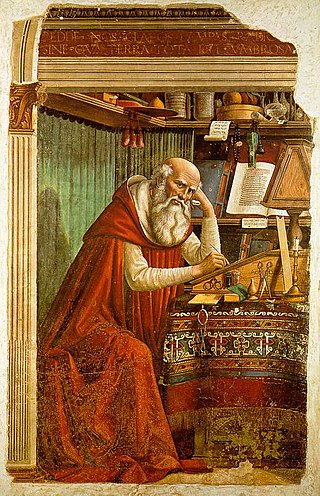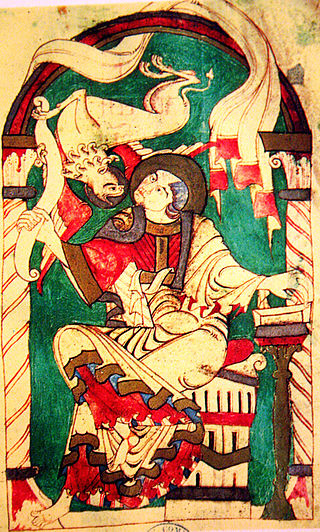Ambrosiaster or Pseudo-Ambrose is the name given to the unknown author of a commentary on the epistles of Saint Paul, written some time between 366 and 384 AD. The name "Ambrosiaster" in Latin means "would-be Ambrose". Various conjectures have been made as to Ambrosiaster's true identity, and several other works have been attributed to the same author, with varying degrees of certainty.

Lobegott Friedrich Constantin (von) Tischendorf was a German biblical scholar. In 1844, he discovered the world's oldest and most complete Bible dated to around the mid-4th century and called Codex Sinaiticus after Saint Catherine's Monastery at Mount Sinai, where Tischendorf discovered it.

The Liber Pontificalis is a book of biographies of popes from Saint Peter until the 15th century. The original publication of the Liber Pontificalis stopped with Pope Adrian II (867–872) or Pope Stephen V (885–891), but it was later supplemented in a different style until Pope Eugene IV (1431–1447) and then Pope Pius II (1458–1464). Although quoted virtually uncritically from the 8th to 18th centuries, the Liber Pontificalis has undergone intense modern scholarly scrutiny. The work of the French priest Louis Duchesne, and of others has highlighted some of the underlying redactional motivations of different sections, though such interests are so disparate and varied as to render improbable one popularizer's claim that it is an "unofficial instrument of pontifical propaganda."

James Ussher was the Church of Ireland Archbishop of Armagh and Primate of All Ireland between 1625 and 1656. He was a prolific scholar and church leader, who today is most famous for his identification of the genuine letters of the church father, Ignatius of Antioch, and for his chronology that sought to establish the time and date of the creation as "the entrance of the night preceding the 23rd day of October... the year before Christ 4004"; that is, around 6 pm on 22 October 4004 BC, per the proleptic Julian calendar.
Procopius of Gaza was a Christian sophist and rhetorician, one of the most important representatives of the famous school of his native place. Here he spent nearly the whole of his life teaching and writing and took no part in the theological movements of his time.

Johann Albert Fabricius was a German classical scholar and bibliographer.

Heinrich Friedrich Wilhelm Gesenius was a German orientalist, lexicographer, Christian Hebraist, Lutheran theologian, Biblical scholar and critic.
Johann Jakob Wettstein was a Swiss theologian, best known as a New Testament critic.

Sedulius was a Christian poet of the first half of the 5th century.

Saint Juliana of Nicomedia is said to have suffered Christian martyrdom during the Diocletianic persecution in 304. She was popular in the Middle Ages, especially in the Netherlands, as the patron saint of sickness.
A homiliarium or homiliary is a collection of homilies, or familiar explanations of the Gospels.
The Corpus Juris Canonici is a collection of significant sources of the canon law of the Catholic Church that was applicable to the Latin Church. It was replaced by the 1917 Code of Canon Law which went into effect in 1918. The 1917 Code was later replaced by the 1983 Code of Canon Law, the codification of canon law currently in effect for the Latin Church. The Corpus juris canonici was used in canonical courts of the Catholic Church such as those in each diocese and in the courts of appeal at the Roman Curia such as the Roman Rota.

Coptic literature is the body of writings in the Coptic language of Egypt, the last stage of the indigenous Egyptian language. It is written in the Coptic alphabet. The study of the Coptic language and literature is called Coptology.
Smaragdus of Saint-Mihiel< OSB was a Benedictine monk of Saint-Mihiel Abbey near Verdun. He was a significant writer of homilies and commentaries.
David Charles Parker OBE (b.1953) was the Edward Cadbury Professor of Theology (2005-2017) and the Director of the Institute for Textual Scholarship and Electronic Editing at the Department of Theology and Religion, University of Birmingham. His interests include New Testament textual criticism and Greek and Latin palaeography.

The Codex Corbeiensis I, designated by ff1 or 9, is an 8th, 9th, or 10th-century Latin New Testament manuscript. The text, written on vellum, is a version of the old Latin. The manuscript contains 39 parchment folios with the text of the four Gospels, Acts of the Apostles, and General epistles.
The Codex Corbeiensis II, designated by ff2 or 8, is a 5th-century Latin Gospel Book. The text, written on vellum, is a version of the old Latin. The manuscript contains 190 parchment folio with the text of the four Gospels with lacunae. Written in a beautiful round uncial hand.
Pseudo-Augustine is the name given by scholars to the authors, collectively, of works falsely attributed to Augustine of Hippo. Augustine himself in his Retractiones lists many of his works, while his disciple Possidius tried to provide a complete list in his Indiculus. Despite this check, false attributions to Augustine abound.
Jean-Claude Haelewyck is a professor emeritus, semiticist, researcher in the fields of the Old Latin Versions of the Bible and Syriac Studies at Centre d’Études Orientales in Institut Orientaliste de Louvain, Université catholique de Louvain and director of FNRS.









